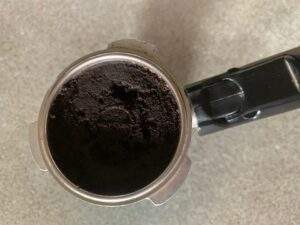Last Updated on 04/02/2023 by Miki
Table of contents
If you’ve ever had a cup of coffee that tastes weak, watery, and unappealing, you’re not alone. Unfortunately, having a watery cup of coffee is all too common and can be due to a variety of reasons. From the type of beans or grinds to how you’re brewing the coffee, there are a few key factors that can cause your cup of joe to be less than satisfactory. In this article, we’ll explore “why is my espresso watery/weak?” and how you can fix it.

Why Is My Espresso Watery/Weak?
There are 8 main reasons why your espresso is watery or weak:
1. You are using too coarse of a grind.
Using too coarse of grind results in an over-extraction of the espresso and a watery flavour. When the particles are too large, the espresso does not extract enough flavour from the coffee grounds, resulting in a watery flavour. Hence, when looking to achieve the desired intensity of espresso, use a finer grind.
2. The coffee is stale or old.
Although there may be several causes of watery espresso, one of the possible reasons is that the coffee beans used are stale or old. Over time, coffee beans lose their flavour, strength and complexity. As a result, when ground and brewed, the espresso can be weak, taste sour and contain more water than usual. To ensure a rich and strong espresso flavour, it’s important to use freshly roasted coffee beans.
3. You are not brewing for long enough.
If your espresso is coming out watery, it is likely that you are not brewing for long enough. Espresso should be brewed for about 25-30 seconds at high pressure so that the grounds have time to extract a full-bodied and flavourful shot. Increasing the brewing time will give the water more time to interact with the grounds and extract more flavour.
4. You are using too much water relative to the amount of coffee grounds used.
When you use too much water, the espresso will be weaker, watered down, and flavourless. The ideal espresso should have a strong flavour, with crema on top. The amount of water used should be in balance with the amount of coffee used, otherwise, it will be watery. To fix this, use less water and more coffee grounds to make a stronger espresso.
5. You are not grinding your beans fresh before brewing.
When it comes to making a good cup of espresso, freshly ground beans are essential. Coffee beans start to lose their flavour and aroma as soon as they are ground, meaning that espresso made from pre-ground beans will taste weak and watery. If you want to make a rich-tasting espresso, you must grind your beans fresh before each use.
6. Your brewing water is too cold or hot.
One of the main keys to a good espresso is temperature. If your espresso is coming out watery, the likely cause is that the brewing water is either too cold or too hot. Colder brewing water will not extract as much of the compounds in the coffee as hotter temperatures do, resulting in a milder, less flavourful espresso. On the other hand, if your brewing water is too hot, it can extract too much from the grounds and leave you with an overly bitter cup of espresso.
7. Your filter is clogged with coffee grounds.
You will need to check if your filter is clogged with residual coffee grounds once you notice your coffee is watery. Coffee grounds will gradually build up in the filter over time, leading to a decrease in pressure that restricts the flow of water through the filter. If this blockage is severe enough, your espresso may end up being too thin and watery.
8. You are tamping down coffee grounds too lightly.
Another potential culprit for a watery espresso is tamping down the coffee grounds too lightly. This can also lead to decreased pressure and a resultant weaker shot. Packing your espresso too loosely will also produce an overly weak and watery extraction. To help ensure an even extraction, it’s important to use the same amount of force each and every time you tamp down your espresso grounds.

How To Fix Your Watery Coffee
- Start by pouring less water when you make coffee. The golden ratio is 2 tablespoons of coffee grounds per 6 ounces of water.
- Use freshly ground coffee instead of pre-ground. Freshly ground coffee has a stronger flavour and stronger taste that can help mask any watery flavour in the coffee.
- If possible, use filtered or bottled water instead of tap water. This can greatly improve the taste of your coffee and reduce its watery flavour.
- Reduce the size of your cup or mug when you are making the coffee. This will result in a stronger flavour since there will be less water in the cup overall. A small cappuccino cup is a good size for making a solid cup of coffee without it being too strong.
- If all else fails, add a little bit of cream or milk to your coffee to help dilute the watery taste. This is an easy way to make it a bit more palatable without adding too much sweetness or fat.
Why Is My Coffee Puck Wet?

A wet coffee puck is caused by the excess water left in the portafilter after the espresso has been extracted. This can happen when the grind size is too fine, the tamping pressure is too high, or the extraction time is too long. To fix this, use a slightly coarser grind size and make sure that the grinds are levelled and packed evenly. Also, it’s important to tamp with just enough pressure so that the puck is level but not too tight. If this step is skipped or not done properly, there will not be enough resistance for the hot water to penetrate through and instead it will spread out over the whole puck making it wet. In addition, it’s important to adjust the extraction time so that it’s neither too short nor too long.
How To Make Stronger Coffee
- Start with a high-quality, fresh-ground coffee. Coffee beans can quickly become stale after grinding, so it’s important to purchase freshly ground coffee or grind your own just before brewing.
- Increase the amount of coffee grounds you use. To make a stronger cup of coffee, use more grounds compared to the amount of water used. As a general rule of thumb, use 2 tablespoons of coffee per 6 ounces of water. For a stronger brew, increase this to 1/4 cup per 6 ounces of water.
- Brew using a French press or espresso machine. Both of these brewing methods allow for more flavour extraction from the grounds compared to other methods like drip machines. When using an espresso machine, you can also increase the pressure to allow for more flavour to be extracted from the beans.
- Brew for a longer period of time. The longer the grounds are in contact with the water, the more caffeine and flavour will be extracted. However, if you brew for too long you will run the risk of over-extraction and bitter-tasting coffee, so use caution.
Final Thoughts
As you can see, there are many reasons why your espresso could be weak and watery. In the end, the best way to fix your espresso is to experiment with the right grind size, tamping pressure, and other variables that could be contributing to your watery espresso shots. With a little bit of trial and error, you should be able to find the sweet spot that produces flavourful espresso shots.
I hope you’ve got the answer to the question “Why is my espresso watery/weak?” in this article and please share your own experience in the comment box below 🙂

